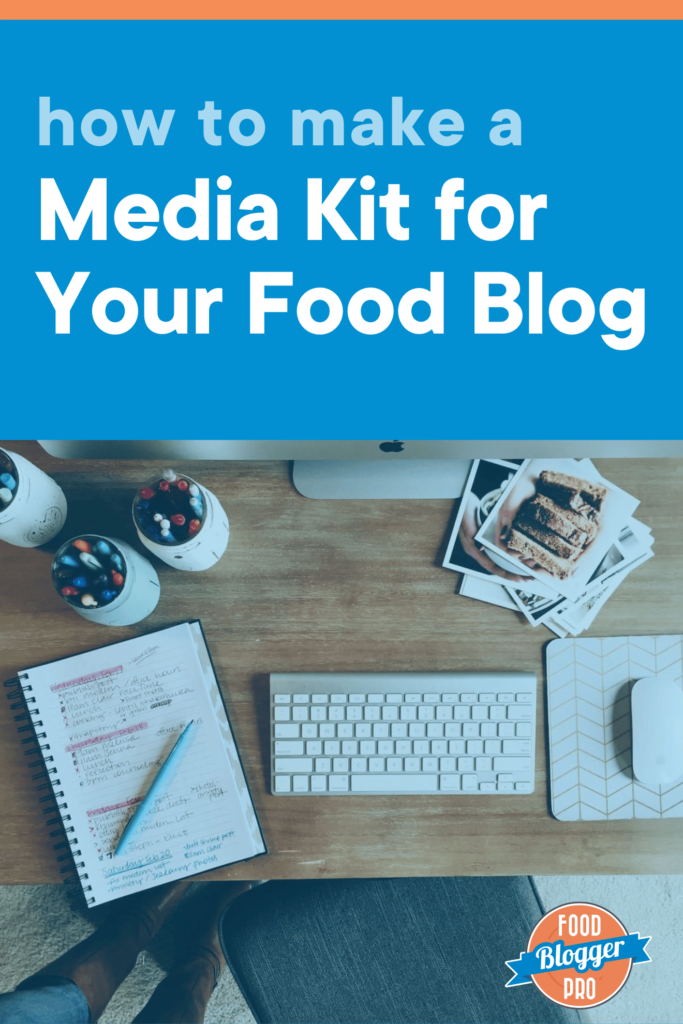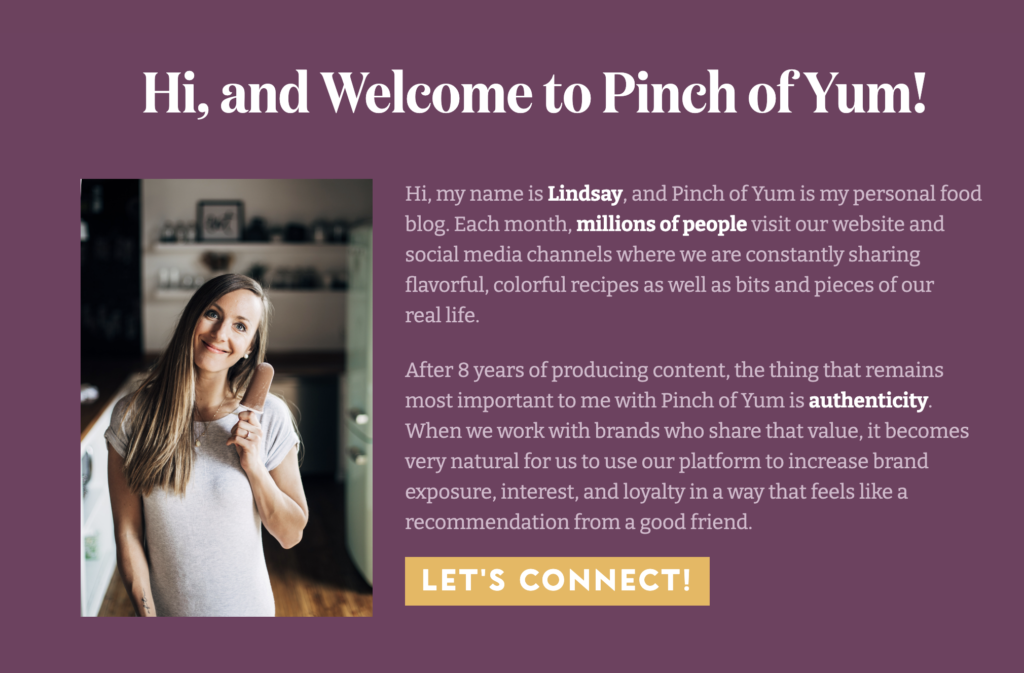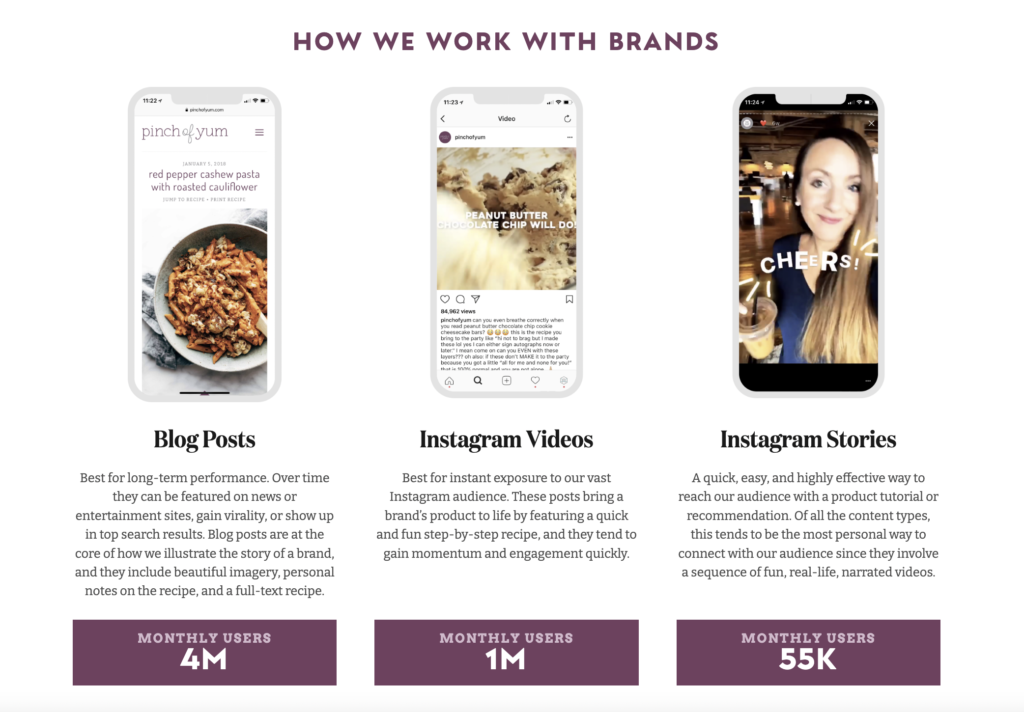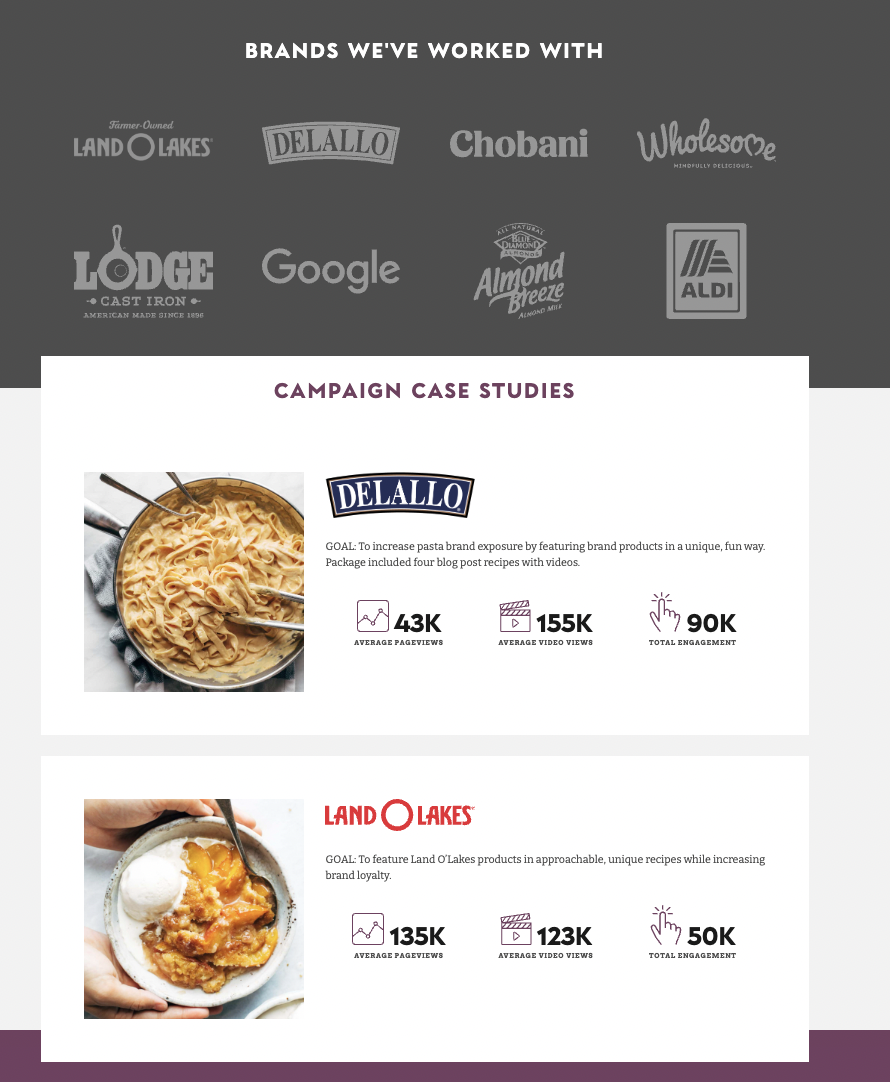There are lots of different ways that food creators can monetize their businesses. While ad networks might be the main source of income for food bloggers with significant traffic, the income from running ads on your site can be less than satisfactory if you’re getting just a few thousand page views per month.
Alternatively, working directly with brands can be a reliable source of income if you are able to start and maintain a sponsorship. For most food bloggers, developing a blog media kit is the first step in the brand partnership journey!
So let’s start with the basics:
- How do you find brands to partner with?
- So what is a blog media kit, exactly?
- What to include in a media kit for your food blog
- But wait! How do I design my media kit?

How do you find brands to partner with?
One way to start a brand collaboration is to sit by your computer and stare at your inbox waiting until a company reaches out to partner with you.
But that can take quite some time, and doing something active may help you move the needle a bit more efficiently!
The more reliable way to go about finding a brand partner is to determine the companies that you think would mesh well with your brand and reach out proactively with a pitch.
This requires time, research, courage, and perseverance; but you’re much more likely to see results.
So, after you’ve found a list of companies to reach out to, what do you say? What do you send them? This is where your media kit really comes in handy.
Want to learn more about negotiating brand partnerships?So what is a blog media kit, exactly?
A media kit is a one or two-page document (often a PDF) or page on your website that sums up your blog in a nutshell. Think of it as your brand’s elevator pitch.
The media kit should provide everything a brand needs to know to make a decision on whether or not you’re a good fit for a partnership.
Now, this isn’t to say that a company won’t ever explore your website or your social media pages. Not at all. But a media kit is your first impression or your foot in the door. If you are thoughtful about putting together your media kit, you’ll have more success converting potential brands into partners.
So what exactly does a media kit contain? Let’s find out!
What to include in a media kit for your food blog
A summary describing you and your blog
People want to work with other people who they feel they have a connection with. In this short blurb, you want to convey who you are, what you do, and what is important to you. It’s also a good idea to include a good headshot of yourself so the person reading your intro can feel like they are hearing the words from you, a real person.
This is where you talk a bit about your blog and why your blog is a good match for them. Explain the type of content you post and share a bit about your brand values. Consider linking to some of your best-performing blog posts in this section!

A look at who your audience is
You have to look at this one from the sponsor’s side. No matter how cool of a person they think you are and no matter how much they love your blog, they still want to make sure that sponsoring your blog will be advantageous to them.
A brand will usually be looking to partner with a food blog with an audience that resembles the demographics of the audience they are trying to reach and sell to. Think age range, gender, location, etc.
You can save yourself time and effort if you do your research beforehand and send your media kit only to those companies that you already know have a similar audience. But don’t be scared to go outside the box either. You never know when a company is trying to reach a different audience than they currently have!
A glance at your business metrics
A lot of sponsorship opportunities require promoting your blog post or the product on social media. Because of this, potential sponsors will want to know more about your followers and engagement on social media, in addition to information about blog traffic.

What metrics should you include? At a minimum, monthly average page views or monthly average unique visitors (use Google Analytics to find these!), and social media following are important to feature. If you have an impressive email subscriber list, include that, too!
Want to learn more about brand partnerships?Details on the services you offer
You will want to set aside some space in your media kit to communicate exactly what types of partnerships you’re looking for. There are a wide range of services a food blogger might offer, including, but not limited to:
- Recipe development
- Food photography
- Videography
- Copywriting
- Guest blogging
- Giveaways
- Food styling
- Sponsored blog posts
- Product reviews
- Sponsored social media posts
- Speaking engagements
- Brand ambassadorship
You certainly don’t need to offer all of these services – pick and choose the services that are the best fit for your skillset and brand.
Information on companies you’ve worked with
If you’ve previously worked with other companies, your media kit is the best place to display that. Brands want to work with desirable bloggers, and showing that you have already worked with other companies for your recipe development, photography skills, or social media reach can help you close the deal.
To display this, you can either list the companies with brief explanations of the partnership or just display their logo to keep it simple. Here’s an example of this in the media kit for Pinch of Yum:

Do you have concrete success metrics or testimonials from previous brand partnerships? Include them here!
Ready to learn more about sponsored content?Contact information
This is almost a no-brainer, but it is something you don’t want to forget! Make it easy for the company to get in contact with you in case they want to start working with you. Provide your email address or include a contact form if your media kit is on your website.
And finally, photographs
As food bloggers, photographs are a big part of what we do, and they can be really instrumental in securing sponsorships. Many companies want to see their product displayed in big, beautiful photographs on your website. So, show off your photography skills by including some of your best photos in your media kit.
But wait! How do I design my media kit?
Good question! Designing and formatting a media kit can be just as difficult as coming up with the content to put in it. So what is a person who’s not all that experienced in design supposed to do?
Fortunately, there is an answer! We have a Creating a Media Kit Course for Food Blogger Pro members, with in-depth lessons all about designing your media kit in InDesign, PhotoShop, and Canva!
Whew, that was quite the list! You should now have everything you need to know to build your very own media kit and start making money with sponsorships. Get to it!
We’re curious… do you have a media kit? What did you include in it?
Great post, Raquel! I just updated my media kit and there are some great tips here that I think will help me make it even better.
I’ve successfully arranged a couple of sponsored posts on my own and haven’t had a problem yet, but I’d feel more comfortable if I had a contract for the brand to sign (or e-sign) so our agreement is nice and clear. Any plans to do a post about that in the future? I’d love to see examples and hear about what’s important to include.
Hi Becky! I’m glad you found the article helpful 🙂 I don’t currently have anything planned for a blog post about sponsor contracts, but I’ll add it to my list and start doing some research. Thanks for the great idea!
Very good post on how to put together a good media kit. Love the sample texts guiding you on what you should put under each section.
This article is excellent, but I’m curious about the pricing for all those services. Where can I find this information? I offer similar services on my website but haven’t set any price points yet. Any guidance on this would be extremely helpful.
Thank you so much for the kind words! Pricing can definitely be a tricky part of the process, but it’s all about finding a balance between the value you provide and what the market will support.
A few things to consider:
1. Industry Standards: There’s no one-size-fits-all pricing, as rates can vary widely based on your niche, audience size, engagement, and experience. It’s always a good idea to reach out to creators with similar followings or styles to get a sense of what they charge (many are surprisingly open to sharing!).
2. Your Unique Value: Factor in your skills, content quality, and the specific benefits you offer brands. Don’t undervalue the time and effort you put into each project.
3. Package Pricing: Consider creating tiered packages or “a la carte” options to give brands flexibility while maximizing your earning potential.
Here’s a good article to get you started on pricing for services! https://www.business.com/articles/set-price-services/